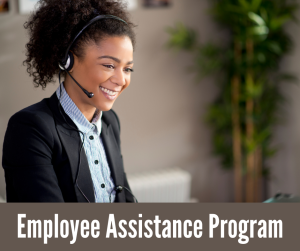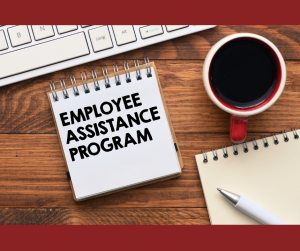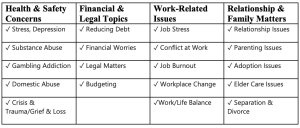
by admin | May 27, 2024 | Health & Wellness, Hot Topics
 Mental health isn’t just the absence of illness. It’s a continuum ranging from severe symptoms such as panic attacks and major depression to excellent mental strength and well-being.
Mental health isn’t just the absence of illness. It’s a continuum ranging from severe symptoms such as panic attacks and major depression to excellent mental strength and well-being.
Sometimes you’re not ill, but you aren’t well either – and you need help. If you’re feeling down about work or a problem in your life and need to talk to somebody, an Employee Assistance Program (EAP) is a great solution.
What is an EAP?
EAPs are mental health services available at work, and they can be beneficial in helping you work through problems. An EAP provides voluntary, confidential services that help you manage personal difficulties and life challenges under the guidance of a professional counselor.
An EAP can provide counseling, support groups, and other resources to help you cope. An EAP is usually offered 24/7, so you can always access it when you need it most. These programs are usually an employee benefit offered by your employer at little or no cost to you.
Employee Assistance Programs aren’t just for crisis situations. They can also provide advice and practical support for:

The Bottom Line
EAPS offer free benefits like short-term therapy, stress management, financial counseling, and relationship support, among other services. Even though they’re short-term, EAP benefits can help you to address issues that have been building up. The end goal of an EAP is to improve your well-being, using a plan that works for your unique circumstances.

by admin | Jun 12, 2023 | Employee Benefits
 As much as employers might prefer that employees’ personal affairs do not interfere with their work, the reality is that problems outside of the workplace can and do impact job performance. Many of these issues go unaddressed due to fear of stigmatization, leading to further declines in employee health and productivity. Anxiety and stress, financial troubles, substance abuse and other personal problems can also lead to increased absenteeism. To help combat these issues, many employers offer a workplace benefit called an Employee Assistance Program (EAP) that is designed to help employees address everyday challenges.
As much as employers might prefer that employees’ personal affairs do not interfere with their work, the reality is that problems outside of the workplace can and do impact job performance. Many of these issues go unaddressed due to fear of stigmatization, leading to further declines in employee health and productivity. Anxiety and stress, financial troubles, substance abuse and other personal problems can also lead to increased absenteeism. To help combat these issues, many employers offer a workplace benefit called an Employee Assistance Program (EAP) that is designed to help employees address everyday challenges.
What is an EAP?
An EAP provides voluntary, confidential services to employees who need help managing personal difficulties or life challenges. The idea is to address personal issues before they interfere with work performance. The employee assistance program is one of the top benefits employers offer in America—for a good reason. They are one way that companies support the well-being of their employees. An EAP generally offers confidential assessment, short-term counseling, referrals and follow-up services for employees.
Typically, an EAP grants employees access to a set number of sessions with a therapist, and the employee would not accrue any co-pay, deductible, or other out-of-pocket costs for the service. For example, Nick has been struggling with depression. To sooth his anxiety, he has begun drinking every day. It’s gradually escalated to the point where he is late to work, has frequent absences, and is missing deadlines. He knows he needs to talk with someone who can offer him alcohol abuse resources. He accesses his company-sponsored EAP.
Meredith is a full-time, married employee with two small children and is also caring for her aging mother who suffers from Alzheimer’s. She is constantly stressed due to the heavy burden of her daily life. The schedule has left her exhausted and she misses work each month due to feeling burnt out. She reaches out to her EAP counselor for time management and mental health tips.
Here are some other common services included in EAPs:

One reason behind the popularity of EAPs is that it’s a mutually beneficial program for employers and employees. After all, your employees are the foundation of your company. Healthy and happy employees are more productive and engaged in their jobs which is great for your company’s bottom line!

by admin | Sep 6, 2017 | Compliance, HIPAA, Human Resources
 When it comes to Employee Assistance Programs, confidentiality is a concern for both employers and employees. As an employer, it is helpful to understand the terms and processes your EAP uses to keep information confidential and ensure that your employees and your workplace are safe.
When it comes to Employee Assistance Programs, confidentiality is a concern for both employers and employees. As an employer, it is helpful to understand the terms and processes your EAP uses to keep information confidential and ensure that your employees and your workplace are safe.
The Health Insurance Portability and Accountability Act (HIPAA) rules apply to EAPs and their affiliate providers. All information that is obtained during an EAP session is maintained in confidential files. The information remains confidential except in the following circumstances:
- An employee/client provides written permission/consent for the release of specific information. This can be done using a Consent to Inform or Release of Information form.
- The life or safety of the client or others is seriously threatened.
- Child abuse has occurred.
- EAP records are the subject of a court order (subpoena).
- Other disclosures required by applicable law.
Depending on the situation, an employee may use EAP services through a self-referral, guided-referral or mandated-referral
Voluntary or self-referrals are the most common. When an employee seeks EAP services voluntarily, all of the employee’s information, including whether he or she contacted the EAP or not, is confidential and cannot be released without written permission.
Guided referrals are an opportunity for the employer to encourage the employee to use EAP services when the employer senses there is a problem that needs to be addressed. This may occur when the employer identifies an employee who may be having personal or work-related difficulties but it is not to the point of mandating that the employee use an EAP. In the case of guided referrals, information disclosed by the employee is still kept confidential.
Mandatory or formal referrals usually occur when substance abuse or other behaviors are impacting productivity or safety. An employer’s policy may allow for putting the employee on a performance improvement plan and may even include a “last chance” agreement that states what an employee must do in order to keep their job. In these cases, employees are mandated by the employer to contact the EAP and a Release of Information is signed so the EAP can exchange information with the employer about employee attendance, compliance and recommendations.
In some cases, it may be advised to send the employee for a Fitness for Duty Evaluation or similar assessment to determine the employee’s ability to physically or mentally perform essential job duties, or assess for a potential threat of violence. These evaluations are performed by specially trained professionals and will come with an additional cost. If the employee has provided written consent, limited information may be released to the employer regarding the results of these evaluations.
By Kathryn Schneider
Originally Published By United Benefit Advisors

by admin | Apr 14, 2017 | Benefit Management, Group Benefit Plans
 Many employers understand the value of having an Employee Assistance Program (EAP) since the heart and soul of organizations are employees. Employees who are physically and mentally healthy, highly productive, engaged in their work, and loyal to their employer contribute positively to their employer’s bottom line. Fortunately, most employees are positive contributors, yet even the best of employees can occasionally have issues or circumstances arise that may inadvertently impact their jobs in a negative way. Having an EAP in place that can address these issues early may mitigate any negative impact to the workplace. This is a win-win for both employees and employers.
Many employers understand the value of having an Employee Assistance Program (EAP) since the heart and soul of organizations are employees. Employees who are physically and mentally healthy, highly productive, engaged in their work, and loyal to their employer contribute positively to their employer’s bottom line. Fortunately, most employees are positive contributors, yet even the best of employees can occasionally have issues or circumstances arise that may inadvertently impact their jobs in a negative way. Having an EAP in place that can address these issues early may mitigate any negative impact to the workplace. This is a win-win for both employees and employers.
A key component of EAP services lies in “catching things early” by assisting employees and helping them address and resolve issues before they impact the workplace. Most employees will use EAP services on a voluntary, self-referred basis that is completely confidential. Some employers may wonder if services are even being used by employees because it won’t be all that apparent, but most EAPs provide a utilization or usage report that will show the number of people served, and possibly the types of reasons services were requested.
If employee issues do begin to appear in the workplace—related to performance, attendance, behavior, or safety—it is important for managers, supervisors, and human resources to also have access to EAP services. They may wish to consult with an employee assistance professional that can provide guidance and direction leading to problem identification and resolution. These issues have the potential to become very costly for the organization—and again, the earlier they can be addressed, the greater chance of success for both employee and employer, with minimal negative impact to the company’s bottom line.
The key to getting the most out of an EAP is to make it easily accessible to employees, safe to use, and visible enough they remember to use it. It is important that employees understand using the EAP is confidential and their identity will not be disclosed to anyone in their organization. Promoting the EAP services with materials such as flyers, posters, or website information with EAP contact information will also increase the likelihood of employees accessing services.
By Nancy Cannon, Originally Published By United Benefit Advisors

 Mental health isn’t just the absence of illness. It’s a continuum ranging from severe symptoms such as panic attacks and major depression to excellent mental strength and well-being.
Mental health isn’t just the absence of illness. It’s a continuum ranging from severe symptoms such as panic attacks and major depression to excellent mental strength and well-being.




